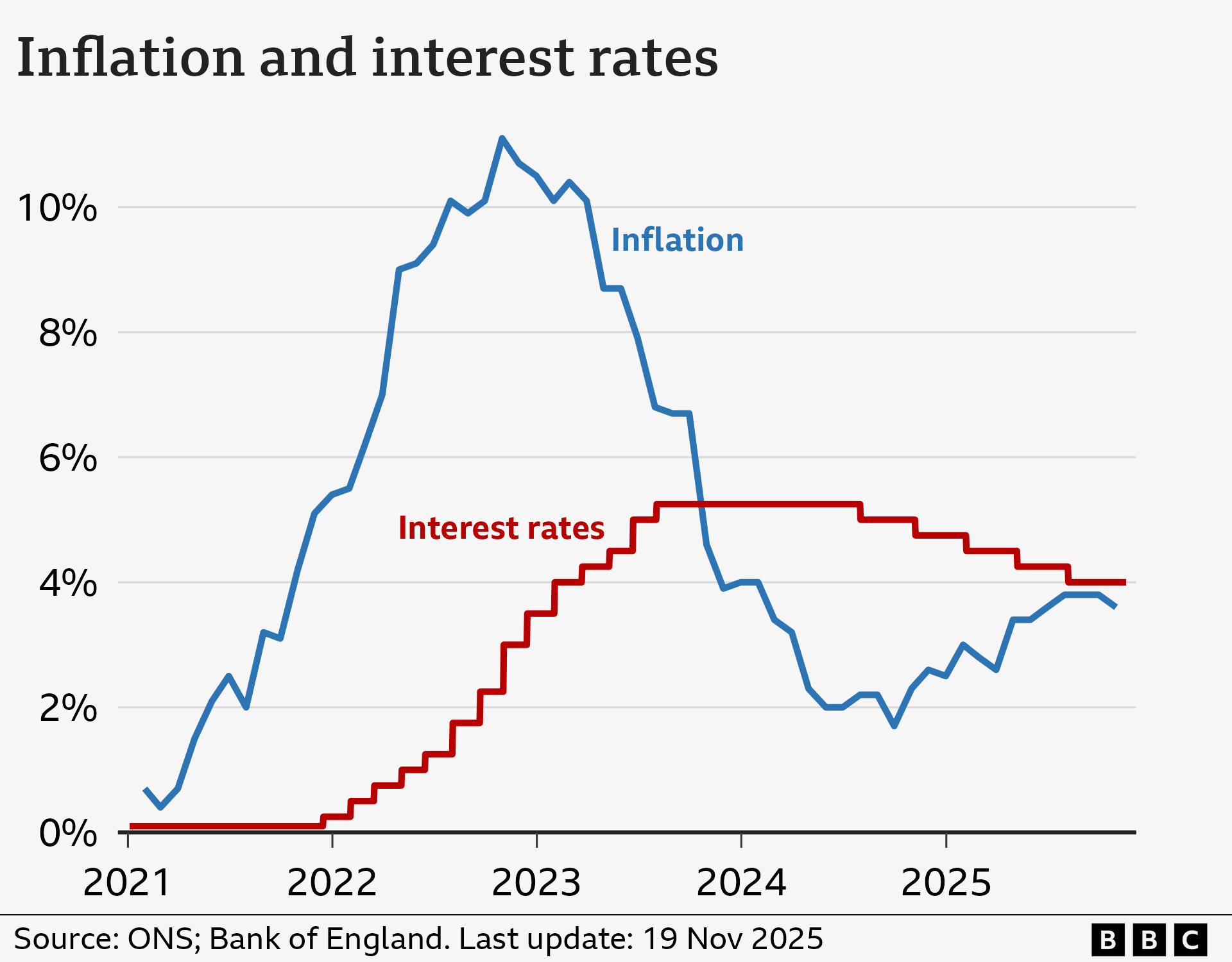When will UK interest rates fall again?

- Published
The Bank of England has kept interest rates at 4%, as it seeks to tackle inflation, which remains well above its 2% target.
But many analysts believe the Bank could cut rates when policymakers next meet in December.
Interest rates affect mortgage, credit card and savings rates for millions of people.
What are interest rates and why do they change?
An interest rate tells you how much it costs to borrow money, or the reward for saving it.
The Bank of England's base rate is what it charges other banks and building societies to borrow money.
That influences what they charge their own customers for loans such as mortgages as well as the interest rate they pay on savings.
The Bank moves rates up and down in order to keep UK inflation - the rate at which prices are increasing - at or near 2%.
When inflation is above that target, the Bank can decide to put rates up. The idea is that this encourages people to spend less, reducing demand for goods and services and limiting price rises.
However, in recent months inflation has remained above the Bank's target at the same time as the economy has remained relatively flat and the jobs market has softened, which makes its decision harder.
What has happened to UK interest rates and inflation?
The Bank of England's base rate reached a recent high of 5.25% in 2023, but five cuts since August 2024 brought it down to 4%.
It then held rates at that level at meetings in September and November.

The main inflation measure, CPI, was 3.6% in the year to October, down slightly from the 3.8% rate recorded in August and September.
It means prices are still rising, but by less than seen in the summer. Inflation remains well above the Bank of England's 2% target.
Rising food prices were the key factor in the overall October CPI figure.
Will UK interest rates fall further?
Many analysts believe there is likely to be a cut when Bank of England policymakers next meet on 18 December.
At the previous meeting in November, the four members of the Bank's nine-member monetary policy committee (MPC) who voted for a cut were only just outvoted by the five who wanted to keep rates on hold.
The Bank's governor, Andrew Bailey, said he would "prefer to wait and see" whether inflation continues to drop back.
Announcements in the Budget on 26 November could also influence the Bank's decision, as well as developments in the global economy.
Mr Bailey has repeatedly warned about the unpredictable impact of US tariffs, and uncertainty around the world.
How do interest rates affect mortgages, loans and savings rates?
Mortgages
Just under a third of households have a mortgage, according to the government's English Housing Survey, external.
About 500,000 homeowners have a mortgage that "tracks" the Bank of England's rate.
But the vast majority of mortgage customers have fixed-rate deals. While their monthly payments aren't immediately affected by a rate change, future deals are.
Mortgage rates are still much higher than they have been for much of the past decade.
As of 19 November, the average two-year fixed residential mortgage rate was 4.88%, according to financial information company Moneyfacts. A five-year rate was 4.93%.
The average two-year tracker rate was 4.66%.
This means many homebuyers and those remortgaging are having to pay a lot more than if they had borrowed the same amount a few years ago.
About 800,000 fixed-rate mortgages with an interest rate of 3% or below are expected to expire every year, on average, until the end of 2027. Borrowing costs for customers coming off those deals are expected to rise sharply.
You can see how your mortgage may be affected by future interest rate changes by using our calculator:
Credit cards and loans
Bank of England interest rates also influence the amount charged on credit cards, bank loans and car loans.
Lenders can decide to reduce their own interest rates if Bank cuts make borrowing costs cheaper.
However, this tends to happen very slowly.

Savings
The Bank base rate also affects how much savers earn on their money.
A falling base rate is likely to mean a reduction in the returns offered to savers by banks and building societies.
The current average rate for an easy access savings account is 2.51%, according to Moneyfacts.
Any further cut in rates could particularly affect those who rely on the interest from their savings to top up their income.
What is happening to interest rates in other countries?
In recent years, the UK has had one of the highest interest rates in the G7 - the group representing the world's seven largest so-called "advanced" economies.
In June 2024, the European Central Bank (ECB) started to cut its main interest rate for the eurozone from an all-time high of 4%.
At its meeting in June 2025 the ECB cut rates by 0.25 percentage points to 2% where they have remained.
In the US, the central bank - the Federal Reserve - cut interest rates in September, and again in October to a range of 3.75% to 4%.
President Trump had repeatedly attacked the Fed for not cutting earlier.